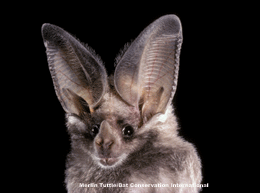Animal Fact Sheet: California Leaf-nosed bat |
Identifying Features The California Leaf-nosed Bat (Macrotus californicus) is the only bat in North America, north of Mexico, with large ears and leaf-like projections on the nose. They are grayish to dark brown on their back and have paler fur below. They have very large ears and an erect triangular flap on nose.
|
 |
Migration/Hibernation These interesting bats do not migrate or hibernate. Because their wings are short and broad they are not suited for long distance flight needed for migration. |
Habitat The California leaf-nosed bats preferred habitats are caves, mines, and rock shelters, mostly in Sonoran desert scrub. Roost sites are usually located near foraging areas. |
Range This species ranges from southern California, southern Nevada, across the southwestern half of Arizona and southward to the southern tip of Baja California, throughout Sonora, northern Sinaloa, and southwestern Chihuahua, Mexico. In Arizona, the California leaf-nosed bat occurs in Sonoran desert scrub south of the Mogollon Plateau. |
Wild Status The California leaf-nosed bat is Federal Species of Concern, an Arizona Game and Fish Department Wildlife of Special Concern, Forest Service Sensitive, and is ranked by the Western Bat Working Group (WBWG) as red/high. The red/high designation is given to species that are imperiled or are at high risk of imperilment. The WBWG recommends these species be given the highest priority for funding, planning, and conservation actions. |
Diet Leaf-nosed bats eat various insects such as crickets,some beetles, grasshoppers, katydids, June beetles, diving beetles; and sphinx and other types of moths. They will capture prey either in flight or off of foliage or the ground. They are the only bats in North America known to catch caterpillars and are among the very few insect-eating bats that supplement their diets with cactus fruit. |
Predators As with many bat species their predators can include owls, snake, coyotes, feral cats and raccoons. |
Reproduction California leaf-nosed bats become pregnant in the fall. The baby develops slowly over the winter, followed by a normal three-and-a-half-month period of rapid development in spring. In May or June, each mother produces a single pup, which she nurses for about a month. Pups are born with eyes and ears open and a body that is already furred. |
Life Span The average life-span of a leaf-nosed bat is 20-30 years in the wild. |
Size The average weight of an adult bat of this species is 0.45 oz (12.75 gm). Their average wingspan is 13 inches (33.02 cm). |
Extra Fun-facts
|